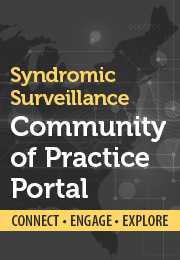New to Syndromic Surveillance?

Syndromic data are captured in nearly real time, which is particularly helpful for assessing the public’s health at any given time or for monitoring specific conditions (i.e., asthma, influenza-like illness). Syndromic surveillance can help you recognize an emerging environmental hazard that affects public health (respiratory problems from a chemical spill) and can also help you identify illness before diagnoses are confirmed and reported.
Because of the immediacy of syndromic data, you’ll need a strong understanding of what these data represent so that your interpretation is accurate. You’ll also need to understand the strengths and limitations of syndromic surveillance before integrating it fully into daily practice.
The resources listed below will help you gain a better understanding of syndromic surveillance.
Syndromic Surveillance
- Syndromic Surveillance 101: An Online Training Course (modules 1–4)
- Centers for Disease Control and Prevention. Overview of Syndromic Surveillance. What is Syndromic Surveillance? MMWR 2004;53(Suppl);5–11.
- Centers for Disease Control and Prevention. Syndromic Surveillance on the Epidemiologist’s Desktop: Making Sense of Much Data; Figure 1, Theoretical framework for response protocols in use of syndromic surveillance systems. MMWR 2005;54(Suppl);141–6.
- Boston Public Health Commission – Syndromic Surveillance (YouTube video)
The National Association of County and City Health Officials made a trip to the bean city for a visit with the Boston Public Health Commission (BPHC). BPHC is a great example of an effective use of syndromic surveillance.
Community of Practice Web Portal
- Connect with Community of Practice which represents all disciplines that contribute to syndromic surveillance.
Monitoring, Analyzing, and Responding to Syndromic Surveillance Data
- ESSENCE User Guide [Internet]. Version 1.0. Florida Department of Health, Bureau of Epidemiology. 2010. Appendix 1: Flowchart for analysis and response to syndromic surveillance data; [cited 2016 Nov 22]. p. 56. Available from www.floridahealth.gov/diseases-and-conditions/disease-reporting-and-management/disease-reporting-and-surveillance/_documents/florida-essence-user-guide.pdf
- International Society for Disease Surveillance. Final recommendation: Core processes and EHR requirements for public health syndromic surveillance [Internet]. Figure 5, Task flow diagram of BP 1—Conduct syndrome-based population health monitoring: Monitor and assist in the assessment, detection, communication, and response to public health conditions of interest; 2011 Jan [cited 2016 Nov 29]; Available from: www.syndromic.org/storage/ISDSRecommendation_FINAL.pdf
- Heffernan R, Mostashari F, Das D, Karpati A, Kulldorff M, Weiss D, et al. Syndromic Surveillance in Public Health Practice, New York City. Emerg Infect Dis. 2004;10(5):858–64. Available from: https://wwwnc.cdc.gov/eid/article/10/5/03-0646_article
- Page last reviewed: May 30, 2017
- Page last updated: May 30, 2017
- Content source:




 ShareCompartir
ShareCompartir